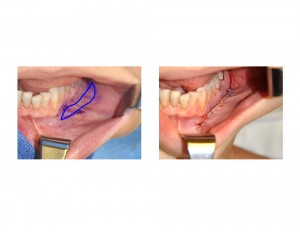From an anatomic perspective, the mouth is made up of two basic parts. There is the oral cavity proper which lies between the teeth where the tongue resides and is bounded superiorly by the palate and inferiorly by the mylohyoid muscles of the floor of the mouth. But the second and often forgotten part of the mouth is the vestibule. This is the lining outside the teeth and between the cheeks and the lips that creates separation between them. This is easy to demonstrate as everyone frequently runs their tongue outside of the teeth, wiping it along the vestibule.
The vestibule plays an important role in oral function as it allows for mobility of the lips and cheeks so these tissues are not attached to the teeth and also permits the opportunity for dental hygiene which would otherwise be difficult without this separation. But having this space permits food to be inadvertently caught in it when chewing. One of the important roles of the tongue is to outside of its interdental space and wipe away any food that has become trapped in it.
Vestibuloplasty surgery is typically a reconstructive surgery to recreate a lost or shortened vestibule. Historically this most most commonly done in the edentulous patient who need a deeper vestibule to allow the flanges of a denture to sit deeper and provide more of a suction fit. This was usually accomplished through the release of the vestibule and the placement of a skin graft. The need for traditional lengthening vestibuloplasty procedures has become less frequent with the development and widespread use of dental implants.

A shortening intraoral vestibuloplasty is a simple procedure that can provide a functional benefit in those patients who have bothersome food trapping in it.
Dr. Barry Eppley
Indianapolis, Indiana


